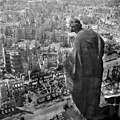This article needs additional citations for verification .(February 2025) |
Dan Cruickshank's Adventures in Architecture is a BBC series first aired on BBC Two in April 2008 in which British architectural historian Dan Cruickshank travels around the world visiting what he considers to be the world's most unusual and interesting buildings, structures and sites. [1] In Australia, the programme was broadcast on ABC1 from 28 May 2009.


































